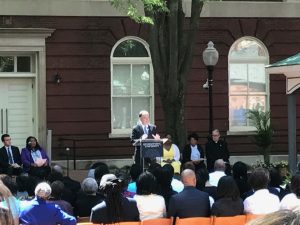Georgetown University Library recently announced it received a logbook from the slave ship the Mary from a donor in California.
The logbook is a record of the day-to-day events of one of the ship’s many voyages in the late 18th century. Researchers believe that an analysis of this logbook will provide a unique insight into the Atlantic slave trade as records of this kind are very rare.
The donor, who is familiar with Georgetown’s efforts to become a center for the study of slavery, reached out to Georgetown graduate Jack Pelose (COL ’19) who helped facilitate the logbook’s transportation to the university. The logbook was found in the back of the donor’s closet and in poor condition upon arrival to the University. It has since been professionally restored and is now available to Georgetown students and researchers at the library. Additionally, a digital copy is available on the library’s website, making it one of only a few slave logbooks available for online viewing in its entirety.
Though the Mary completed many journeys between North America and Africa—many of which are included in the Trans-Atlantic Slave Database—the logbook is the only original record available from this ship. According to Georgetown History Professor Adam Rothman, this is one of only a dozen surviving logbooks from the slave ships that brought enslaved persons to North America. The majority of surviving records from that time are from ships that traveled to the Caribbean or Latin America.
“Documentation about the slave trade is pretty extensive, but these records—extant logbooks—are fairly rare,” Rothman wrote in the library’s announcement.
The Mary belonged to Cyprian Sterry, the most active slave trader in Providence, Rhode Island, at the time. Sterry funded 18 voyages during which more than 1,500 enslaved persons were transported from Africa to the United States and the Caribbean. The last known voyage of one of Sterry’s vessels was in May of 1797 after the Providence Abolition Society threatened to sue Sterry for violating the government’s law limiting the Atlantic slave trade.
The logbook provides an extensive record from one of the ship’s voyages. Under the command of Captain Nathan Sterry, the Mary departed from Providence on Nov. 22, 1795, arriving on the west coast of Africa on Dec. 24, 1795. The ship left Africa with 142 enslaved African men, women, and children on June 17, 1796. On Aug. 19, 1796, it arrived in Georgia where many of the enslaved people were sold. The writer of this logbook is unclear, but it’s believed to be an assistant of Captain Sterry.
Rothman explained that the Mary’s logbook is a significant contribution to the history of the slave trade as it provides a detailed account of the daily occurrences aboard the ship. The information recorded in the logbook includes how the ship was outfitted, provisions traded for slaves, episodes of resistance, deaths, location, nautical conditions, state of the crew, work done aboard the ship, and commercial transactions.
“It provides an unparalleled window into the operations of the Atlantic slave trade” Rothman commented in a video on the acquisition.
The records of slave resistance and death are particularly interesting to scholars. There is very little detail about enslaved persons beyond a numbered identifier.
“We don’t know their names. We don’t know their biographies. We don’t know where they came from. We don’t know anything about their families. All we know is what’s recorded in this journal: that they died at sea,” Rothman said in the video after noting the lack of detail in the logbook.
It is known that on this voyage slaves were acquired from several ports along the Senegambia, Windward Coast, and Gold Coast and that the majority of the slaves were purchased by a Mr. Robertson of Charleston and a Spanish merchant. However, beyond this transactional information, the logbook provides minimal insight into the identities of the slaves aboard this voyage.
“Buried one boy slave n. 21” reads a record of death in the logbook. No names or specific origins were recorded, making it difficult to track the individual identities of the slaves transported on this ship. By the end of the journey, 38 slaves had died from either suicide, injuries from harsh discipline, or infectious disease. The logbook also records instances of rebellion or uprising during the journey, often followed by violent punishment.
Such detailed day-to-day information provides insight into the voyages themselves, helping push research beyond records of departure and arrival. Though it provides minimal insight into the identities of those enslaved, the logbook serves as a reminder of the individuals whose lives were permanently altered by the slave trade, a perspective that can often be lost in a large scale examination.
Rothman intends to use the logbook in his classes on Atlantic history and the history of slavery. He hopes to utilize the logbook in a digital storytelling project in which readers can follow the ship’s journey on a map.
“The arrival of the logbook of the Mary adds a new dimension to the archival resources that we have at our disposal to study the history of slavery and the slave trade,” Rothman explained in the video.
Georgetown graduate student Hillary MacKinlay (G’21) is currently working on transcribing the logbook. The physical copy of the manuscript and its accompanying digital copy are difficult to read due to damage, faded text, and hard to read handwriting. Though a partial transcript was published in the 1930s, MacKinlay’s transcription will include a more accurate record of the full logbook.
It is the hope of those working with the logbook that the donation will help expand Georgetown’s long-term mission to more deeply understand the legacy of slavery in the United States, and the role Georgetown played in this injustice. Rothman believes that student engagement with the text will help further this mission.
“The fact that this artifact is now at an institution dedicated to teaching and research really gives it a new lease on life and it becomes not just an artifact of study but a memorial to the history of the trade,” Rothman remarked in the library’s video.






[…] Credit: Source link […]